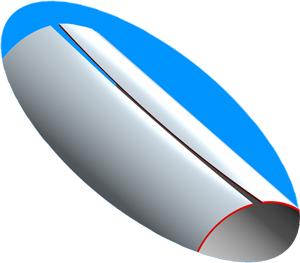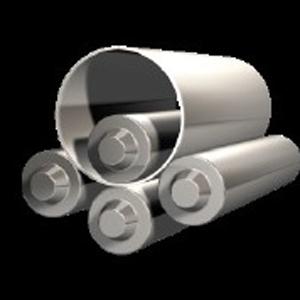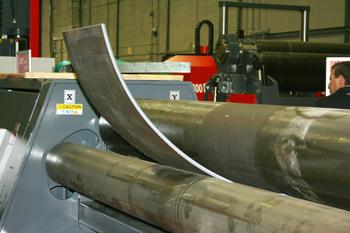President
- FMA
- The Fabricator
- FABTECH
- Canadian Metalworking
Categories
- Additive Manufacturing
- Aluminum Welding
- Arc Welding
- Assembly and Joining
- Automation and Robotics
- Bending and Forming
- Consumables
- Cutting and Weld Prep
- Electric Vehicles
- En Español
- Finishing
- Hydroforming
- Laser Cutting
- Laser Welding
- Machining
- Manufacturing Software
- Materials Handling
- Metals/Materials
- Oxyfuel Cutting
- Plasma Cutting
- Power Tools
- Punching and Other Holemaking
- Roll Forming
- Safety
- Sawing
- Shearing
- Shop Management
- Testing and Measuring
- Tube and Pipe Fabrication
- Tube and Pipe Production
- Waterjet Cutting
Industry Directory
Webcasts
Podcasts
FAB 40
Advertise
Subscribe
Account Login
Search
Don’t get flattened by the wrong plate roll
Answering these questions can help you select the right equipment
- By Kyle Jorgenson
- October 7, 2013
- Article
- Bending and Forming
Editor’s Note: The following was adapted from a presentation made at a dealer meeting at JMT USA in August 2013.
Although dramatic advances in machine technology have largely decreased dependency on seasoned machine operators, plate rolling still requires a lot of skill—or “tribal knowledge.”
A few metal fabricators are lucky enough to have a talented roll operator on staff. These experienced operators have comprehensive knowledge about materials and rolling practices, which enables them to control this extremely dynamic fabricating process.
Plate rolling is not like working a press brake, where there is a single bend and one direction of inertia. A plate roll involves multiple forces and directions of inertia as the forming takes place. If operators don’t understand this science and the
process dynamics, they are forced to use “proprietary radius finders,” also commonly known as hammers, chains, cranes, forklifts, come-alongs, oxyacetylene torches, and jacks of all types.
Aside from a skilled operator, the machine you choose is equally imperative for effective plate rolling. Answering the following questions will help you find the best machine for your plate rolling projects.
What Type of Material Am I Rolling?
Yield, tensile strength, width, thickness, and diameter (or radius) of the part all have to be considered. These properties, more than anything else, determine the proper plate roll sizing. For example, a higher yield or tighter diameter will require more pressure to form.
Also, minimum and maximum width is important. Even something as straightforward as material thickness can vary, yet still fall into accepted plate and sheet mill tolerances. For instance, a 0.25-in. plate can sometimes vary in thickness from 0.23 to 0.262 in.
On the application side, you need to know the minimum and maximum diameter of the cylinders to be formed and if cones or special shapes will be made. All of this information is integral in finding the correct type and size of plate roll. The end goal is to achieve parallel surfaces while producing the diameter you need.
Do I Understand the Importance of Crowning?
Keep in mind that most metal fabricators are going to require a plate roll to work with many materials, which will affect the machine’s rolls in different ways. To accommodate this variety, most manufacturers’ rolls are machined with optimal crowning (see Figure 1).

Figure 1: During plate rolling of any material thickness, deflection—the amount of deviation from the plane where the rollers contact the material—is a given. It occurs at all points of contact, but is greatest at the center. Crowning is used to adjust the rollers and correct the material’s deviation from the plane.
Typically, optimal crowning is 75 percent of nominal capacity, with all things—yield, width, diameter, pinch pressure, and speed—being equal. For instance, a machine with 1-in. nominal rolling capacity will form very nice 0.75-in.-thick cylinders (under the right pressure), with all surfaces parallel to each other and producing the same radius or diameter throughout the part. However, on this same machine, 0.25-in. material may yield long before enough pressure is applied to deflect crowning out of rolls that is needed for the thicker end of the machine’s range. The result is an hourglass-shaped part—a part tighter in the middle than at the ends.
The range of a roll (thickness/width/diameter) really depends on the tolerance—with accepted variance—of your parts. Options can be installed on the machine to adjust for different tolerances. Specific crowning can be applied to any machine to reach the desired range of material characteristics and part tolerances. Adjusting the pinch pressure can affect or change the parallelism of the roll contact surfaces.
What can happen with insufficient crowning? You don’t get a satisfactory roll form.
A barrel effect is one result of insufficient crowning (see Figure 2). The part has a greater diameter in the middle than at the ends.
An hourglass effect is another possible deformation (see Figure 3). In this case, the material is tighter in the middle than on the ends.
For advice on combating these plate rolling problems, see the Combating Crowning Deformations sidebar.
What Type of Machine Fits My Production Needs?
Certain types of plate rolling machines are easier to operate than others. Also, cone rolling or rolling of a special shape, such as elliptical, can be accomplished with greater accuracy on certain types of machine. Let’s take a quick look at some of the machines types to see why this is so.
Four-roll Machines. These machines produce the fastest and most accurate bends (see Figure 4). The plate is held securely in place between the top and bottom rolls, while the side rolls move vertically to create the bend. The bottom roll moves up to hold the plate surface securely against the top roll while the side roll is raised to form an accurate prebend, minimizing the flat zone on the plate edge. Prebending on a three-roll machine requires that plates be tilted down as they are being fed. In contrast, on a four-roll machine plates are loaded horizontally at the feed level for prebending, which allows the use of horizontal motorized roller tables to help feed the plate.
Plate feeding can take place on either side of a four-roll machine. If fed from only one side, they can even be placed up against a wall to save floor space.

Figure 2: To correct a barrel crowning deformation, a plate rolling machine operator might consider focusing crowning more on the center at the beginning of the roll.
The side rolls are positioned to the right and left of the bottom roll and are on their own axes. The independent axis of each roll helps make a perfect bend. The so-called “back” side roll (at the far side of the feeding point) also functions as a backgauge to square the plate for proper alignment. This eliminates the need for someone to assist the operator.
The plate is kept square without slipping during both prebending and rolling because of the constant secure clamping of the top and bottom rolls.
Four-roll machines do not require the operator to remove, flip, and then try to square the plate a second time after prebending, as is the case with three-roll, initial-pinch machines. Because the material can be kept in the machine, a cylinder can be rolled to the required diameter immediately following prebending.
Bending the back edge takes place after the cylinder is rolled. This allows for a one-direction, single-pass operation.
To perform cone-rolling on a four-roll machine, the side rolls can be tilted to establish the cone angle, and the bottom roll also can be tilted to clamp and drive the major end of the cone.
Three-roll, Variable-geometry Machines. The widest range of material types and thickness in relation to the size of the top roll can be rolled on three-roll, variable-geometry machines (see Figure 5). They are suitable for medium and thick plate bending.
Unlike traditional three-roll cylinder machines, the lower rolls on three-roll, variable geometry machines move horizontally right to left, and the upper roll moves up and down. As on four-roll machines, material loads parallel to the floor, so the machine pit can be constructed to working level.
By design, the upper roll can be used as a traditional press. Side rolls can move close under the top roll, so that thinner plate bending can be done on smaller diameters. Also, top and side rolls have tilt capability for cone bending.
Three-roll, Double-pinch Machines. These machines are economical plate rolls that are relatively easy to operate (see Figure 6).
The side rolls are positioned to the right and left of the top roll and are on the same axis. The axis of each roll helps make the bend. The “back” side roll (at the far side of the feeding point) also functions as a backgauge to square the plate for proper alignment. This eliminates the need for someone to assist the operator.

Figure 3: Easing off the crowning at the start of a roll is one way to correct an hourglass deformation.
Three-roll, double-pinch machines do not require the operator to remove, flip, and then try to square the plate a second time after prebending, as is the case with three-roll, initial-pinch machines. Because the material can be kept in the machine, a cylinder can be rolled to the required diameter immediately following prebending, which is not possible in three-roll, initial-pinch machines.
For cone rolling on a three-roll, double-pinch machine, the side rolls can be tilted to establish the cone angle.
Do I Require a Mar-free Finish on the Rolled Parts?
If you require a mar-free finish, you need polished, precision-ground rollers. They are easy to clean and won’t pick up mill scale as much as traditional rollers.
With these specialty rollers, however, comes a need for vigilance. You have to be careful with what you send through the rollers, because even though they are hardened, they still can be damaged. (You have to be especially vigilant when rolling narrow pieces, because all the pressure of the machine can be focused on a very small area.)
If you need to have rollers made out of specialty alloys, you won’t suffer sticker shock. The cost of the rollers typically isn’t exorbitant, but of course, the application ultimately might justify the cost.
What Part Handling Options Do I Need for My Rolling Applications?
A plate rolling application could require NC or CNC side and overhead supports, motorized loading tables, plate alignment systems, infeed conveyors, or part ejectors. These are important safety and productivity tools that should not be forgotten when choosing a new plate rolling machine.
Some of these options might be only a small percentage of the purchase price, but could have extremely fast return on investment.
Will I Be Doing Any Welding in the Plate Roller?
This may sound like a small detail, but it can become a big deal. Welding around expensive controls found on a new plate rolling machine could lead to extensive electrical damage from the welding power source. It could fry the system.
You need to take special care to make sure the welding ground is on the part, not on the machine.
It never starts out like that, but before a shop realizes it, a welder is on top of the plate roller trying to join up the two ends. It’s convenient, but if it’s done improperly and without the correct protection on the machine, controls and electrical systems can be damaged.

Figure 4: Four-roll machines are the only type of plate rolls that can effectively make use of NC and CNC because of the constant clamping and driving of the material during all steps of rolling.
If you even think that this is a possibility, you need to have an upgraded, shielded electronic system to protect the plate rollers’ electronics. It’s better to be safe than sorry.
Plenty to Consider
Plate rolling is an art when compared to some other fabricating processes, but having the right equipment and accessories for the job can help even a new operator turn out quality rolled parts after a few days of training. You shouldn’t be intimidated with the thought of rolling; it just might be a new forming option to offer your customers.
About the Author
Kyle Jorgenson
385 N. 700 W
North Salt Lake, UT 84054
844-768-4636
Related Companies
subscribe now

The Fabricator is North America's leading magazine for the metal forming and fabricating industry. The magazine delivers the news, technical articles, and case histories that enable fabricators to do their jobs more efficiently. The Fabricator has served the industry since 1970.
start your free subscription- Stay connected from anywhere

Easily access valuable industry resources now with full access to the digital edition of The Fabricator.

Easily access valuable industry resources now with full access to the digital edition of The Welder.

Easily access valuable industry resources now with full access to the digital edition of The Tube and Pipe Journal.
- Podcasting
- Podcast:
- The Fabricator Podcast
- Published:
- 04/16/2024
- Running Time:
- 63:29
In this episode of The Fabricator Podcast, Caleb Chamberlain, co-founder and CEO of OSH Cut, discusses his company’s...
- Trending Articles
AI, machine learning, and the future of metal fabrication

Employee ownership: The best way to ensure engagement

Dynamic Metal blossoms with each passing year

Steel industry reacts to Nucor’s new weekly published HRC price

Metal fabrication management: A guide for new supervisors

- Industry Events
16th Annual Safety Conference
- April 30 - May 1, 2024
- Elgin,
Pipe and Tube Conference
- May 21 - 22, 2024
- Omaha, NE
World-Class Roll Forming Workshop
- June 5 - 6, 2024
- Louisville, KY
Advanced Laser Application Workshop
- June 25 - 27, 2024
- Novi, MI




























